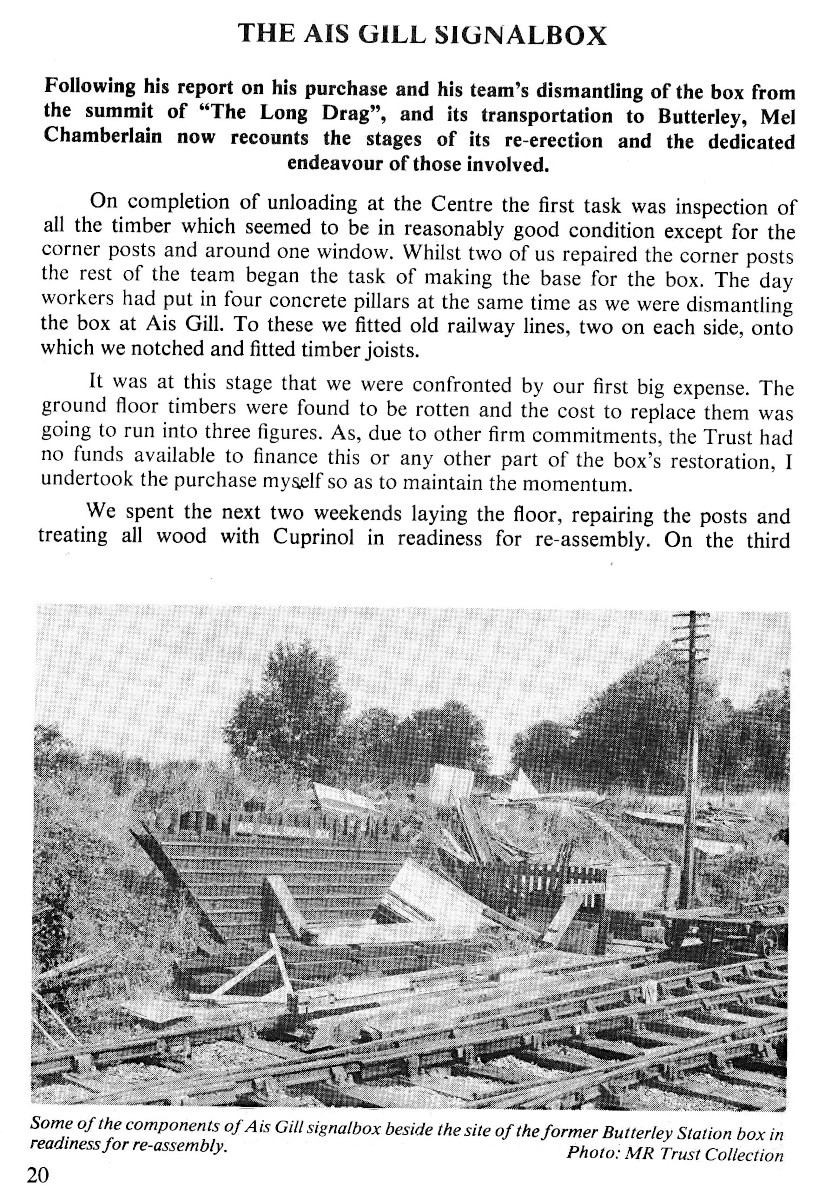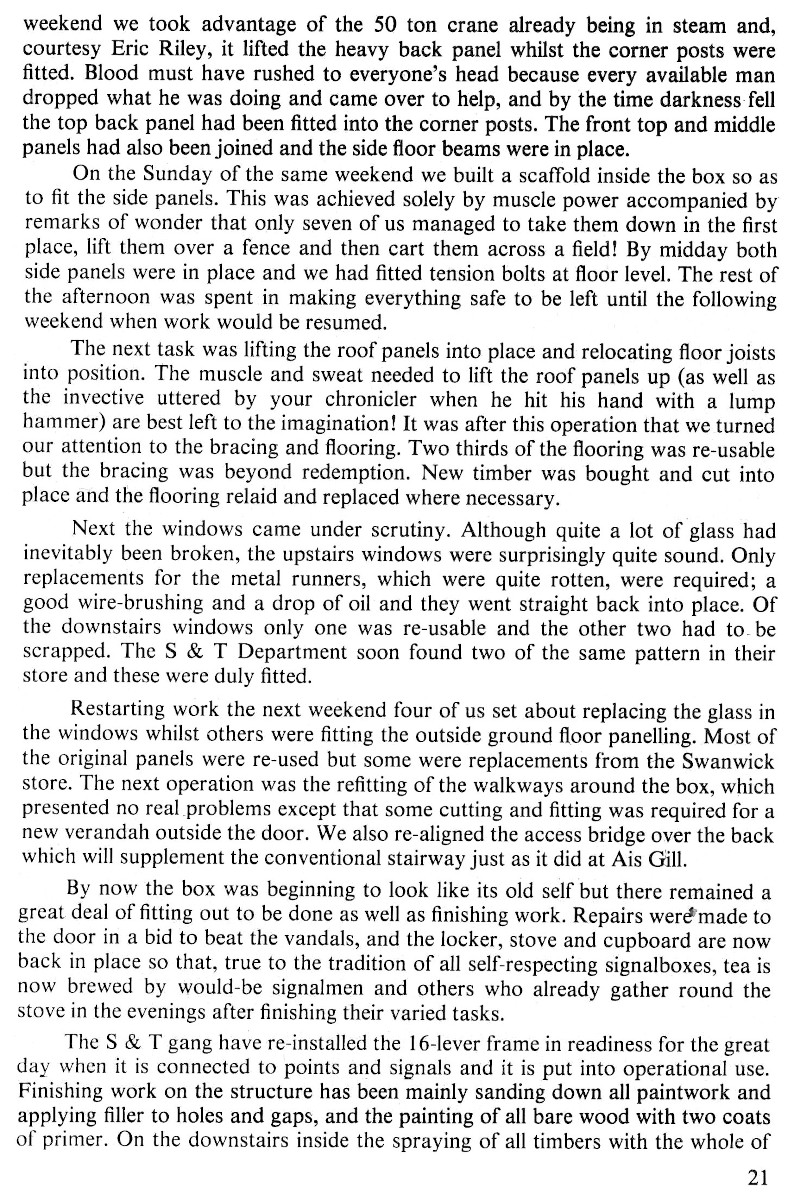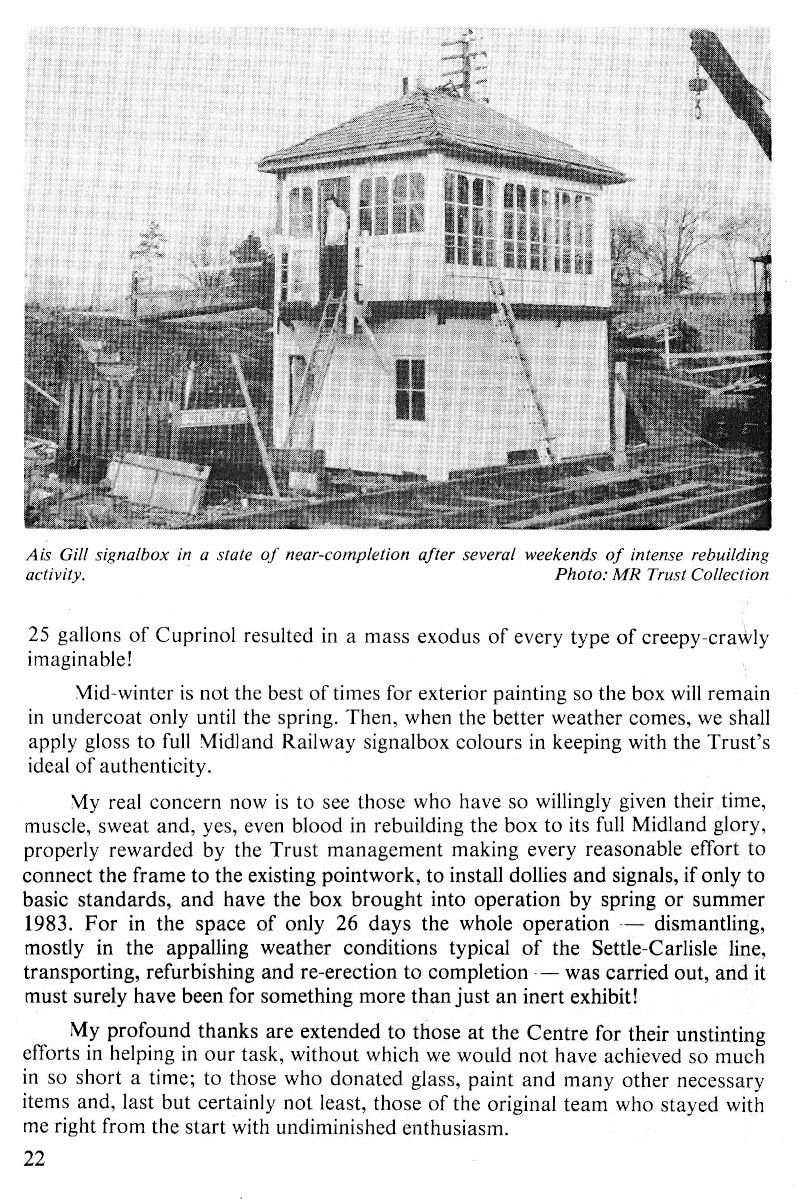The following is a facsimile reproduction and full transcript of an article that appeared on pages 20-23 of the Winter 1982-83 edition (issue no. 52) of the Midland Railway Trust's journal 'Wyvern'.
The photographs have not been reproduced separately as they can be viewed on the page facsimiles.
Pages scanned from the original journal
Full transcript of article text
THE AIS GILL SIGNALBOX
Following his report on his purchase and his team's dismantling of the box from the summit of "The Long Drag", and its transportation to Butterley, Mel Chamberlain now recounts the stages of its re-erection and the dedicated endeavour of those involved.
On completion of unloading at the Centre the first task was inspection of all the timber which seemed to be in reasonably good condition except for the corner posts and around one window. Whilst two of us repaired the corner posts the rest of the team began the task of making the base for the box. The day workers had put in four concrete pillars at the same time as we were dismantling the box at Ais Gill. To these we fitted old railway lines, two on each side, onto which we notched and fitted timber joists.
It was at this stage that we were confronted by our first big expense. The ground floor timbers were found to be rotten and the cost to replace them was going to run into three figures. As, due to other firm commitments, the Trust had no funds available to finance this or any other part of the box's restoration, I undertook the purchase myself so as to maintain the momentum.
[PHOTOGRAPH WITH CAPTION: "Some of the components of Ais Gill signalbox beside the site of the former Butterley Station box in readiness for re-assembly. Photo: MR Trust Collection."]
We spent the next two weekends laying the floor, repairing the posts and treating all wood with Cuprinol in readiness for re-assembly. On the third weekend we took advantage of the 50 ton crane already being in steam and, courtesy Eric Riley, it lifted the heavy back panel whilst the corner posts were fitted. Blood must have rushed to everyone's head because every available man dropped what he was doing and came over to help, and by the time darkness fell the top back panel had been fitted into the corner posts. The front top and middle panels had also been joined and the side floor beams were in place.
On the Sunday of the same weekend we built a scaffold inside the box so as to fit the side panels. This was achieved solely by muscle power accompanied by remarks of wonder that only seven of us managed to take them down in the first place, lift them over a fence and then cart them across a field! By midday both side panels were in place and we had fitted tension bolts at floor level. The rest of the afternoon was spent in making everything safe to be left until the following weekend when work would be resumed.
The next task was lifting the roof panels into place and relocating floor joists into position. The muscle and sweat needed to lift the roof panels up (as well as the invective uttered by your chronicler when he hit his hand with a lump hammer) are best left to the imagination! It was after this operation that we turned our attention to the bracing and flooring. Two thirds of the flooring was re-usable but the bracing was beyond redemption. New timber was bought and cut into place and the flooring relaid and replaced where necessary.
Next the windows came under scrutiny. Although quite a lot of glass had inevitably been broken, the upstairs windows were surprisingly quite sound. Only replacements for the metal runners, which were quite rotten, were required; a good wire-brushing and a drop of oil and they went straight back into place. Of the downstairs windows only one was re-usable and the other two had to be scrapped. The S & T Department soon found two of the same pattern in their store and these were duly fitted.
Restarting work the next weekend four of us set about replacing the glass in the windows whilst others were fitting the outside ground floor panelling. Most of the original panels were re-used but some were replacements from the Swanwick store. The next operation was the refitting of the walkways around the box, which presented no real problems except that some cutting and fitting was required for a new verandah outside the door. We also re-aligned the access bridge over the back which will supplement the conventional stairway just as it did at Ais Gill.
By now the box was beginning to look like its old self but there remained a great deal of fitting out to be done as well as finishing work. Repairs were made to the door in a bid to beat the vandals, and the locker, stove and cupboard are now back in place so that, true to the tradition of all self-respecting signalboxes, tea is now brewed by would-be signalmen and others who already gather round the stove in the evenings after finishing their varied tasks.
The S & T gang have re-installed the 16-lever frame in readiness for the great day when it is connected to points and signals and it is put into operational use. Finishing work on the structure has been mainly sanding down all paintwork and applying filler to holes and gaps, and the painting of all bare wood with two coats of primer. On the downstairs inside the spraying of all timbers with the whole of 25 gallons of Cuprinol resulted in a mass exodus of every type of creepy-crawly imaginable!
[PHOTOGRAPH WITH CAPTION: "Ais Gill signalbox in a state of near completion after several weekends of intense rebuilding activity. Photo: MR Trust Collection."]
Mid-winter is not the best of times for exterior painting so the box will remain in undercoat only until the spring. Then, when the better weather comes, we shall apply gloss to full Midland Railway signalbox colours in keeping with the Trust's ideal of authenticity.
My real concern now is to see those who have so willingly given their time, muscle, sweat and, yes, even blood in rebuilding the box to its full Midland glory, properly rewarded by the Trust management making every reasonable effort to connect the frame to the existing pointwork, to install dollies and signals, if only to basic standards, and have the box brought into operation by spring or summer 1983. For in the space of only 26 days the whole operation — dismantling, mostly in the appalling weather conditions typical of the Settle-Carlisle line, transporting, refurbishing and re-erection to completion — was carried out, and it must surely have been for something more than just an inert exhibit!
My profound thanks are extended to those at the Centre for their unstinting efforts in helping in our task, without which we would not have achieved so much in so short a time; to those who donated glass, paint and many other necessary items and, last but certainly not least, those of the original team who stayed with me right from the start with undiminished enthusiasm.
Acknowledgements
The SCRCA Project team gratefully acknowledges the assistance received from Chris Deeth (a member of the Midland Railway Trust's 'Archive & Collections Team') for supplying a copy of this article and for granting us permission to reproduce it here. For further information regarding the Trust, please visit its website at: https://www.midlandrailway-butterley.co.uk/



